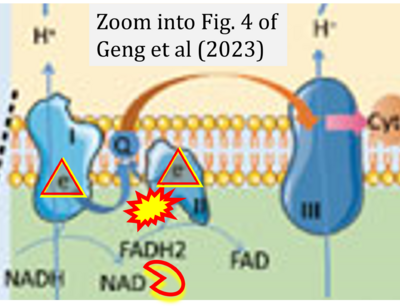Geng 2023 Front Physiol
| Geng Y, Hu Y, Zhang F, Tuo Y, Ge R, Bai Z (2023) Mitochondria in hypoxic pulmonary hypertension, roles and the potential targets. Front Physiol 14:1239643. https://pubmed.ncbi.nlm.nih.gov/37645564/10.3389/fphys.2023.1239643 |
Geng Yumei, Hu Yu, Zhang Fang, Tuo Yajun, Ge Rili, Bai Zhenzhong (2023) Front Physiol
Abstract: Mitochondria are the centrol hub for cellular energy metabolisms. They regulate fuel metabolism by oxygen levels, participate in physiological signaling pathways, and act as oxygen sensors. Once oxygen deprived, the fuel utilizations can be switched from mitochondrial oxidative phosphorylation to glycolysis for ATP production. Notably, mitochondria can also adapt to hypoxia by making various functional and phenotypes changes to meet the demanding of oxygen levels. Hypoxic pulmonary hypertension is a life-threatening disease, but its exact pathgenesis mechanism is still unclear and there is no effective treatment available until now. Ample of evidence indicated that mitochondria play key factor in the development of hypoxic pulmonary hypertension. By hypoxia-inducible factors, multiple cells sense and transmit hypoxia signals, which then control the expression of various metabolic genes. This activation of hypoxia-inducible factors considered associations with crosstalk between hypoxia and altered mitochondrial metabolism, which plays an important role in the development of hypoxic pulmonary hypertension. Here, we review the molecular mechanisms of how hypoxia affects mitochondrial function, including mitochondrial biosynthesis, reactive oxygen homeostasis, and mitochondrial dynamics, to explore the potential of improving mitochondrial function as a strategy for treating hypoxic pulmonary hypertension.
• Bioblast editor: Gnaiger E
Correction: FADH2 and Complex II
- FADH2 is shown as the substrate feeding electrons into Complex II (CII). This is wrong and requires correction - for details see Gnaiger (2024).
- Gnaiger E (2024) Complex II ambiguities ― FADH2 in the electron transfer system. J Biol Chem 300:105470. https://doi.org/10.1016/j.jbc.2023.105470 - »Bioblast link«
Hydrogen ion ambiguities in the electron transfer system
Communicated by Gnaiger E (2023-10-08) last update 2023-11-10
- Electron (e-) transfer linked to hydrogen ion (hydron; H+) transfer is a fundamental concept in the field of bioenergetics, critical for understanding redox-coupled energy transformations.
- However, the current literature contains inconsistencies regarding H+ formation on the negative side of bioenergetic membranes, such as the matrix side of the mitochondrial inner membrane, when NADH is oxidized during oxidative phosphorylation (OXPHOS). Ambiguities arise when examining the oxidation of NADH by respiratory Complex I or succinate by Complex II.
- Oxidation of NADH or succinate involves a two-electron transfer of 2{H++e-} to FMN or FAD, respectively. Figures indicating a single electron e- transferred from NADH or succinate lack accuracy.
- The oxidized NAD+ is distinguished from NAD indicating nicotinamide adenine dinucleotide independent of oxidation state.
- NADH + H+ → NAD+ +2{H++e-} is the oxidation half-reaction in this H+-linked electron transfer represented as 2{H++e-} (Gnaiger 2023). Putative H+ formation shown as NADH → NAD+ + H+ conflicts with chemiosmotic coupling stoichiometries between H+ translocation across the coupling membrane and electron transfer to oxygen. Ensuring clarity in this complex field is imperative to tackle the apparent ambiguity crisis and prevent confusion, particularly in light of the increasing number of interdisciplinary publications on bioenergetics concerning diagnostic and clinical applications of OXPHOS analysis.
Labels:
Stress:Hypoxia
Tissue;cell: Lung;gill




